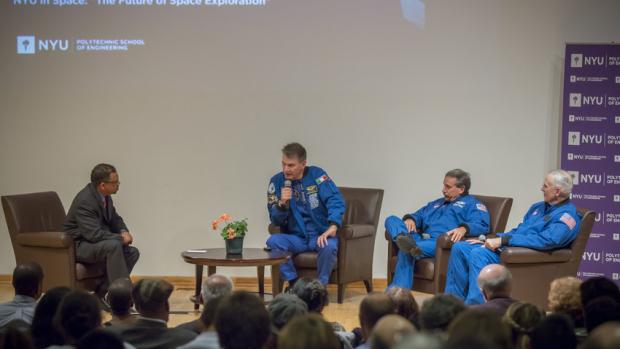Bringing Outer Space to Brooklyn
Speakers on the Square Features Alumni Astronauts

“It’s definitely the blue jumpsuits,” Lee Morin joked. “If we took these off, we’d fade into anonymity.” Morin was speaking while shaking hands, signing autographs, and posing for cell-phone photos with excited fans who had come out to hear him speak, along with fellow astronauts Charles Camarda and Paolo Nespoli, at “Speakers on the Square…Astronauts in Brooklyn,” an event sponsored by the NYU Polytechnic School of Engineering and the NYU Alumni Association.
It was something of a homecoming for the three, since each is an NYU graduate. Camarda had earned his undergraduate degree in aerospace engineering in 1974; Morin’s NYU degrees include a master’s in biochemistry (1978) and a doctorate of both medicine and microbiology (‘81 and ‘82); and Nespoli holds a B.S. in aerospace engineering (’88) and an M.S. in aeronautics and astronautics (‘89).
“We’re feeling a lot of pride tonight,” Gerry Dawes (‘84 ’89), the president of the Polytechnic Institute Alumni Association (PIAA), asserted, unable to resist quipping, “It feels out of this world.” Frank Namad (’68), a fellow PIAA official sitting next to him, added, “This just goes to prove how far an NYU education can take you—even all the way into space.”
Collectively, Camarda, Morin, and Nespoli—who were joined on stage by Lockheed Martin aerospace engineer Nicholas Mitchell (’92) as discussion moderator—have logged 200 days in space during a variety of missions, which have included, in the case of Nespoli, a 159-day stay at the International Space Station.
The group was introduced to the audience by Dean Katepalli Sreenivasan, who, despite his own accomplishments as a renowned physicist, admitted that he never dreamed as a child that he could become an astronaut. “I knew I could be a scientist, diplomat, or even poet, but astronaut was out of the realm of possibility,” he said. “These men are living proof that we can reach for the stars both literally and figuratively.”
Mitchell kept the discussion lively, asking several compelling questions—including why we need an international presence in space. “We live in a global society, and we need to be able to work and communicate with others,” Camarda replied. “Some technical problems are addressed differently by different people; there are no homogeneous solutions, and it’s very important to realize that with diversity comes imagination and ingenuity.” Gesturing to a slide of the International Space Station, Nespoli concurred, and added, “It gives me hope. If we can accomplish this in space, think of what we are capable of accomplishing on Earth.”
Asked about the future of space exploration and what their priorities would be if they ruled NASA, the astronauts let their imagination soar. “We probably all grew up fantasizing about living on the moon,” Morin said. “There would be entire cities built there and bases on Mars. But that didn’t happen because there’s something called the rocket equation that basically says it’s very hard to put things into space.” Explaining that in six Apollo missions, the mass carried into space equaled that of just a single moving van’s worth of items, he detailed his “Rocks into Robots” dream, which calls for using resources already there—such as the sun’s energy and the powdery substance called regolith—to manufacture needed items via robotic remote control (a process known as telepresence). “We need to move information, not matter,” he asserted. Camarda pointed out that the School of Engineering team had made a great showing at the recent Fifth Annual NASA Robotic Mining Competition, in which a student-designed robot deposits as much simulated regolith into a collection bin within 10 minutes as possible.
When the floor opened to questions, one student asked what the astronauts did for fun while in space. Despite general consensus that NASA and ESA did not pay them to have fun, Morin finally admitted, “You know that famous trick where the magician levitates someone and passes a hoop around their body? Well, in space you can actually do that.”




